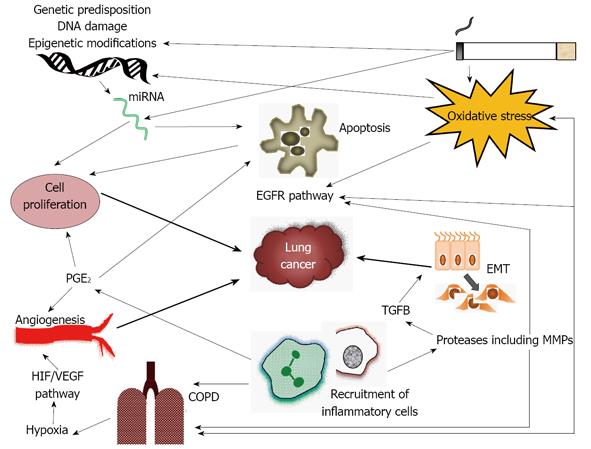Copyright
©2013 Baishideng Publishing Group Co.
World J Respirol. Nov 28, 2013; 3(3): 67-76
Published online Nov 28, 2013. doi: 10.5320/wjr.v3.i3.67
Published online Nov 28, 2013. doi: 10.5320/wjr.v3.i3.67
Figure 1 Pathogenic processes linking chronic obstructive pulmonary disease and lung cancer.
The figure shows some of the key pathways leading to both chronic obstructive pulmonary disease (COPD) and cancer, and demonstrates the complexity of the interactions between the diseases. Cigarette smoke causes oxidative stress which can both drive inflammation and occur due to inflammation; both processes lead to COPD. Inflammation may in turn lead to activation of matrix metalloproteases (MMPs) and the transforming growth factor β (TGFβ) pathway, which by way of epithelial mesenchymal transition can promote lung cancer growth. Oxidative stress may also directly activate the epidermal growth factor receptor pathway which is involved in lung cancer growth. Cigarette smoke also interacts with pre-existing genetic predisposition and causes changes in DNA and miRNA which lead to processes relevant to cancer growth, such as cell proliferation and apoptosis, as well as to COPD. Finally, COPD may cause hypoxia which may augment angiogenesis, thereby interacting with prostaglandin based pathways to influence cell proliferation further, with the potential to influence cancer risk. EGFR: epithelial growth factor; EMT: epithelial cell mesenchymal transition; PGE2: Prostaglandin E2; HIF: Hypoxia inducible factor; VEGF: Vascular endothelial growth factor.
- Citation: Green CE, Turner AM. Role of chronic obstructive pulmonary disease in lung cancer pathogenesis. World J Respirol 2013; 3(3): 67-76
- URL: https://www.wjgnet.com/2218-6255/full/v3/i3/67.htm
- DOI: https://dx.doi.org/10.5320/wjr.v3.i3.67









